Frankenmuth Historical Museum


Frankenmuth Historical Museum
Get close enough to this "photograph" of Wilhelm Loehe and he'll become animated and speak to you.
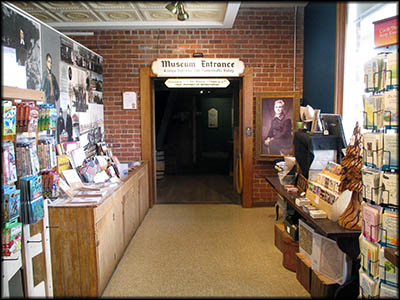
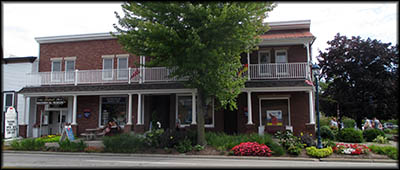
Museum Entrance
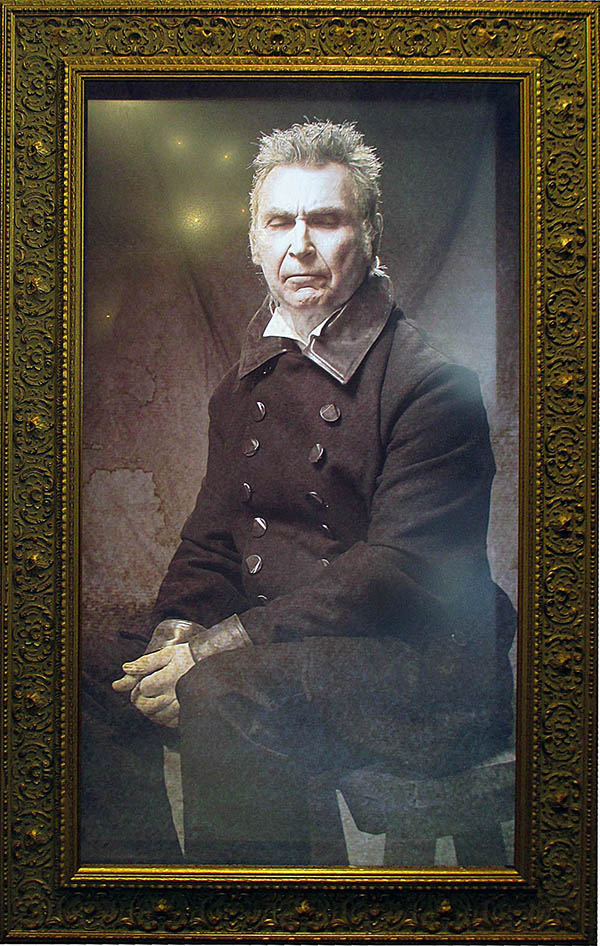
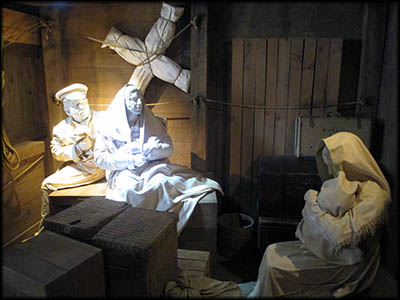
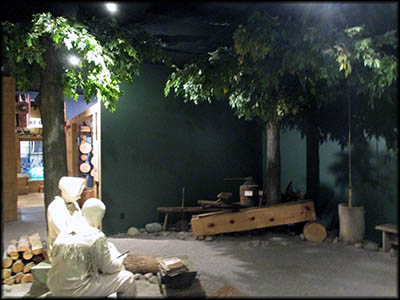
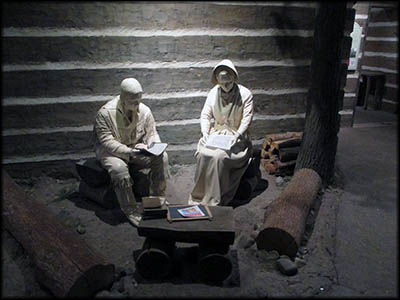
Sailing on the Caroline
Scenes of Early Settlers
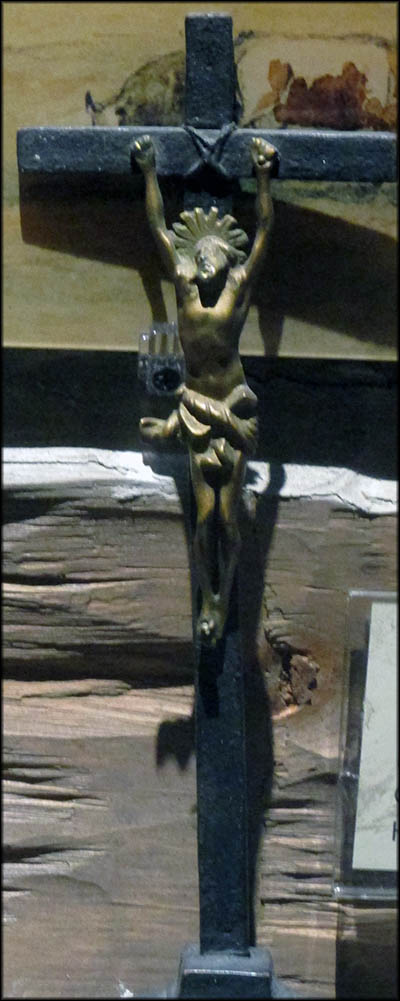
Crucifix from a Lutheran Church
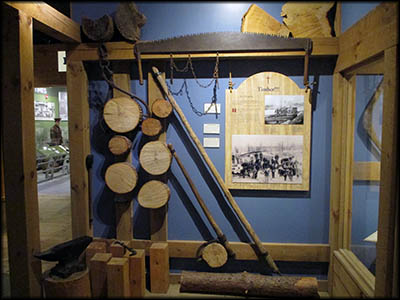
Lumber Industry Exhibit
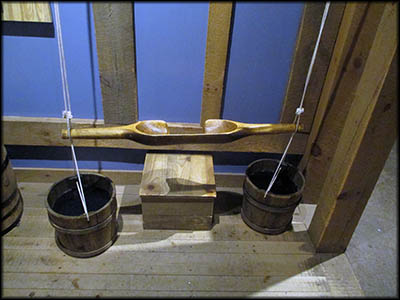
Early settlers got their water from a well and used a yoke to carry to buckets. Visitors can try this out for themselves.
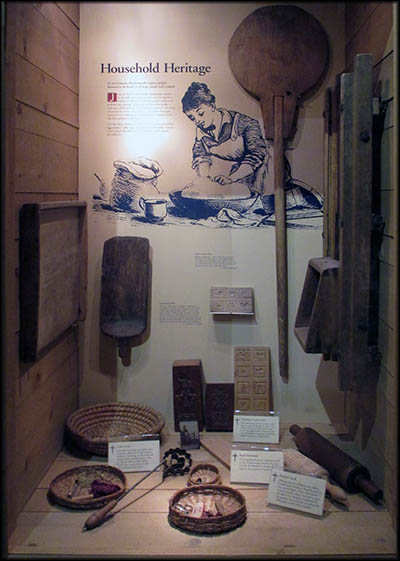
19th Century Household Items from Frankenmuth
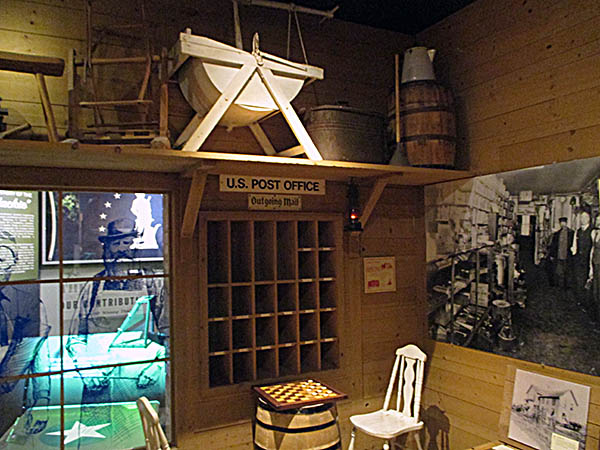
U.S. Post Office Exhibit
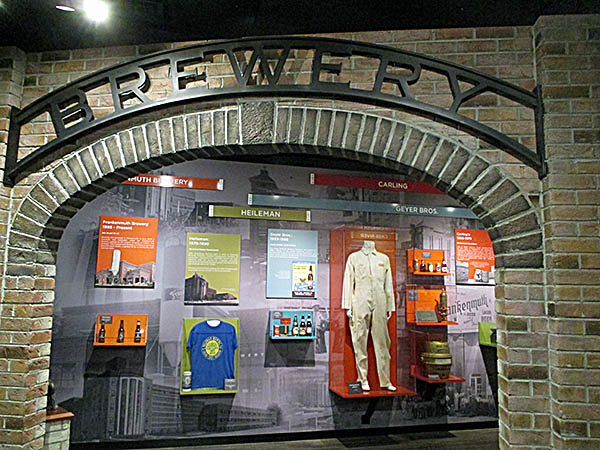
Brewery Exhibition
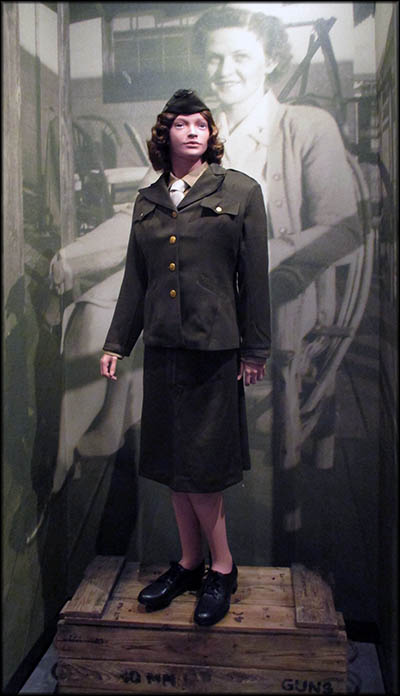
Lorna Roth
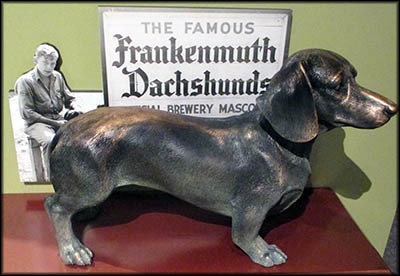
Frankie was the Frankenmuth Brewing Company's mascot starting in the 1930s.
Squeezed along Main Street’s shopping section in the small town of Frankenmuth, Michigan, is the Frankenmuth Historical Museum. I’m a big advocate of visiting local history museums because they usually focus on how the people that area once lived by showcasing artifacts and written or oral accounts from their lives. Many small town museums suffer from a lack of money and staff, forcing them to have limited hours. Frankenmuth Historical Museum bucks this trend. It’s open year round, often seven days a week. One reason it can do this, I suspect, is because the city of Frankenmuth is Michigan’s biggest tourist destination. It attracts over three million visitors a year. Considering the town has a population of just under 5,200, that’s a lot of people in such a limited space.
Frankenmuth sets along the Cass River in Saginaw Valley, a region that was first settled by U.S. citizens and European immigrants after the 1819 Treaty of Saginaw pushed the native people already living there out. Among these early settlers were Germans fleeing from persecution and a lack of opportunities in their homeland. Most who came to settle the American frontier cared little about religion, and this didn’t go unnoticed by Lutheran minister Friedrich Conrad Dietrich Wyneken. He’d emigrated from the Kingdom of Hanover in 1838 and, upon arriving in America, began working with his fellow Germans immigrants throughout Ohio, Indiana and Michigan. He believed they needed some serious religious leadership.
While back in Hanover in 1841 having a throat ailment tended to, he published Die Noth der deutschen Lutheraner in Nordamerika (The Distress of the German Lutherans in North America) to encourage missionaries and ministers to head to the United States to tend to the religious needs of Germans Lutherans living on the American frontier. He traveled throughout the German states (then a hodgepodge of electorates, kingdoms, duchies and principalities) to spread his message to fellow Lutheran ministers. He also wrote letters, and one of his pen pals was Johann Konrad Wilhelm Loehe (sometimes spelled Löhe), the pastor of a small church located in the rural Bavarian town of Neuendettelsau.
Frankenmuth sets along the Cass River in Saginaw Valley, a region that was first settled by U.S. citizens and European immigrants after the 1819 Treaty of Saginaw pushed the native people already living there out. Among these early settlers were Germans fleeing from persecution and a lack of opportunities in their homeland. Most who came to settle the American frontier cared little about religion, and this didn’t go unnoticed by Lutheran minister Friedrich Conrad Dietrich Wyneken. He’d emigrated from the Kingdom of Hanover in 1838 and, upon arriving in America, began working with his fellow Germans immigrants throughout Ohio, Indiana and Michigan. He believed they needed some serious religious leadership.
While back in Hanover in 1841 having a throat ailment tended to, he published Die Noth der deutschen Lutheraner in Nordamerika (The Distress of the German Lutherans in North America) to encourage missionaries and ministers to head to the United States to tend to the religious needs of Germans Lutherans living on the American frontier. He traveled throughout the German states (then a hodgepodge of electorates, kingdoms, duchies and principalities) to spread his message to fellow Lutheran ministers. He also wrote letters, and one of his pen pals was Johann Konrad Wilhelm Loehe (sometimes spelled Löhe), the pastor of a small church located in the rural Bavarian town of Neuendettelsau.
Loehe, it ought to be noted, greets you pass from the gift shop into the museum proper. Hanging beside the entrance doorway is what at first appears to be Loehe’s photograph, but as soon as you get close enough, he comes alive and speaks! Usually animations like this creep into the uncanny valley—the state when figures are almost but not perfectly lifelike in a way that’s disturbing—but Loehe’s animation was done well enough not be too troubling.
He believed that the colonists should bring the word of God to the “heathen” Native Americans as well as serve as missionaries to the German Lutherans already living there. He decided the site would be along the Cass River in Saginaw Valley because it was remote enough to ensure that the colonists wouldn’t stop speaking their native tongue in favor of English like so many other German immigrants were doing. He christened the settlement “Frankenmuth.” “Franken” represented Bavaria’s Province of Franconia from which all colonists came, and “muth” meant “courage.” The word “Frankenmuth” translates as “courage of the Franconians.”
He had no intention of going himself, so he recruited fifteen men, women, and children to seed this new colony. On April 20, 1845, the colonists set sail from Bremen for the United States on the ship Carolina. Aside from religious zeal, another thing that likely motivated these volunteers to leave Bavaria was their dislike of the ten percent tax put on beer by their King Ludwig I in 1844, which had sparked riots and caused general unrest. Beer was (and still is) an integral part of Bavarian culture, and making it more expensive was not a good move on the king’s part. Bavarians, it ought to be noted, preferred lager, the brewing of which they invented in the fifteenth century.
He believed that the colonists should bring the word of God to the “heathen” Native Americans as well as serve as missionaries to the German Lutherans already living there. He decided the site would be along the Cass River in Saginaw Valley because it was remote enough to ensure that the colonists wouldn’t stop speaking their native tongue in favor of English like so many other German immigrants were doing. He christened the settlement “Frankenmuth.” “Franken” represented Bavaria’s Province of Franconia from which all colonists came, and “muth” meant “courage.” The word “Frankenmuth” translates as “courage of the Franconians.”
He had no intention of going himself, so he recruited fifteen men, women, and children to seed this new colony. On April 20, 1845, the colonists set sail from Bremen for the United States on the ship Carolina. Aside from religious zeal, another thing that likely motivated these volunteers to leave Bavaria was their dislike of the ten percent tax put on beer by their King Ludwig I in 1844, which had sparked riots and caused general unrest. Beer was (and still is) an integral part of Bavarian culture, and making it more expensive was not a good move on the king’s part. Bavarians, it ought to be noted, preferred lager, the brewing of which they invented in the fifteenth century.
Loehe chose August Craemer to be the colony’ pastor. Born in 1819, Craemer had his own reasons for escaping from the German states. He’d languished in prison from 1833 to 1839 for his participation in the Frankfurt Insurrection, a failed attempt to storm a police station from which the attackers would take over the German Confederation’s treasury and start a democratic revolution. After his release from prison, Craemer moved for a time to Britain where he taught at Oxford. In addition to being fluent in German and English, he also knew Greek, Latin, and Norwegian. Once in Michigan, he’d add Chippewa to his language repertoire.
The journey to get to the new land was quite an ordeal. As she exited the Weser River into the North Sea, the Carolina ran into a sandbank. She was forced by contrary winds to sail around Scotland instead taking the shorter route through the English Channel. She collided with an English trawler along the way. For the entire trip she sailed through foul weather that confined the passengers belowdecks where smallpox broke out. From this dread disease three died, one of whom was the toddler Margaretha Haspel, whose parents, Martin and Anne, were the only couple married when the settlers left port. Quite a few others, Craemer included, married while on board.
The survivors arrived in New York City on June 8, 1845. When they reached the place where they’d start their new settlement, they discovered it consisted of a thick, old growth forest riddled with malaria that needed to be cleared for farming. Shelters consisting of log cabins also had to be built, and neither was easy. Craemer, when not busy helping with these tasks, established a mission school for the children of Chippewas. It didn’t attract many students: few Chippewas wanted to embrace the conservative version of Lutheranism on offer, or to assimilate into the Bavarian culture.
The journey to get to the new land was quite an ordeal. As she exited the Weser River into the North Sea, the Carolina ran into a sandbank. She was forced by contrary winds to sail around Scotland instead taking the shorter route through the English Channel. She collided with an English trawler along the way. For the entire trip she sailed through foul weather that confined the passengers belowdecks where smallpox broke out. From this dread disease three died, one of whom was the toddler Margaretha Haspel, whose parents, Martin and Anne, were the only couple married when the settlers left port. Quite a few others, Craemer included, married while on board.
The survivors arrived in New York City on June 8, 1845. When they reached the place where they’d start their new settlement, they discovered it consisted of a thick, old growth forest riddled with malaria that needed to be cleared for farming. Shelters consisting of log cabins also had to be built, and neither was easy. Craemer, when not busy helping with these tasks, established a mission school for the children of Chippewas. It didn’t attract many students: few Chippewas wanted to embrace the conservative version of Lutheranism on offer, or to assimilate into the Bavarian culture.
The settlers split the land into lots for farming. In first couple years they cultivated potatoes and corn, later expanding into dairy cereal crops such as wheat, barley, and oats. Their diet remained consistent with what they’d eaten in Bavaria, their staples being mainly cheeses and sausages. During 1846 more colonists arrived. Most of them were from Bavaria or surrounding German states, and they were far more interested in bettering their lives and prospering in ways not possible back home than they were with missionary work.
Frankenmuth became a mecca for small businesses. A flour mill was established in 1847 on the Cass River. By 1875 there were at least twenty-five businesses operating in the village of Frankenmuth including a blacksmith, wagon shops, a sawmill, a hotel, a drugstore, shoemakers and cobblers. The villagers’ diet remained firmly German in nature. A museum information says, “by 1895[,] five of Frankenmuth’s approximately 30 businesses processed meat, sausage, or cheese.”
That many breweries operated in Frankenmuth over the years is no surprise given the Bavarian love for beer. In 1857 John Matthias Fallier opened the village’s first beer making venture called Frankenmuth Brewery. Its beer wasn’t especially high quality nor was the quantity great. His brew kettle held just 200 gallons. Fallier sold his brewery in 1864, and a succession of owners failed to make it prosper. Closing in 1880, John Stahl bought and reopened it as Stahl Beer & Depot, but this only lasted four years.
Frankenmuth became a mecca for small businesses. A flour mill was established in 1847 on the Cass River. By 1875 there were at least twenty-five businesses operating in the village of Frankenmuth including a blacksmith, wagon shops, a sawmill, a hotel, a drugstore, shoemakers and cobblers. The villagers’ diet remained firmly German in nature. A museum information says, “by 1895[,] five of Frankenmuth’s approximately 30 businesses processed meat, sausage, or cheese.”
That many breweries operated in Frankenmuth over the years is no surprise given the Bavarian love for beer. In 1857 John Matthias Fallier opened the village’s first beer making venture called Frankenmuth Brewery. Its beer wasn’t especially high quality nor was the quantity great. His brew kettle held just 200 gallons. Fallier sold his brewery in 1864, and a succession of owners failed to make it prosper. Closing in 1880, John Stahl bought and reopened it as Stahl Beer & Depot, but this only lasted four years.
Fallier’s cousins Martin Heubisch and William Knaust founded Frankenmuth’s the first large scale, commercial brewery in 1862. Setting up along the Cass River, they called it the Cass River Brewery. They sold it in 1874 to John C. Geyer, who renamed it Geyer Brothers’ Brewery. Geyer had learned brewing in his native Bavaria and brought that knowledge with him to Frankenmuth in 1869.
The implementation of Prohibition in 1920 put most of Frankenmuth’s breweries out of business. Other adapted. An example of the latter was the Frankenmuth Brewing Company (which was not the same one founded by Fallier despite the company’s claim on its website). After closing for a time, it reopened as Frankenmuth Products. Under this new name, it produced and sold malt extract used by people who wanted to brew beer at home. Illicit alcohol was also available in Frankenmuth. Zehnder’s Restaurant sold it to those who ordered “hot tea,” a venture that lasted until July 30, 1930, when a U.S. Treasury agent stopped for a meal and ordered what he believed really was hot tea. Soon after his discovery, Prohibition agents raided the restaurant as well as the Fischer Hotel on the other side of the street. Both were given heavy fines, but Zehnder’s negotiated a lower one in exchange for destroying its hand-carved bar.
Prohibition ended in 1933 and it wasn’t long before new breweries opened. Frankenmuth Products changed its name back to Frankenmuth Brewing Company and introduced its iconic mascot, Frankie the dachshund. In 1956 Carling’s bought Frankenmuth Brewing and expanded its plant, which it then sold in 1979.
When World War I broke out, many of the original German immigrants who moved to Frankenmuth were still alive and well. They overwhelmingly supported the United States when it entered the conflict. During World War II, the people of Frankenmuth again supported the U.S. in the war effort. The city’s Woolen Mill, for example, produced 66,000 pairs of woolen socks that were good at preventing general infantrymen from getting trench foot. Victory gardens sprung up throughout the area and many care packages were sent to the American soldiers fighting overseas.
The implementation of Prohibition in 1920 put most of Frankenmuth’s breweries out of business. Other adapted. An example of the latter was the Frankenmuth Brewing Company (which was not the same one founded by Fallier despite the company’s claim on its website). After closing for a time, it reopened as Frankenmuth Products. Under this new name, it produced and sold malt extract used by people who wanted to brew beer at home. Illicit alcohol was also available in Frankenmuth. Zehnder’s Restaurant sold it to those who ordered “hot tea,” a venture that lasted until July 30, 1930, when a U.S. Treasury agent stopped for a meal and ordered what he believed really was hot tea. Soon after his discovery, Prohibition agents raided the restaurant as well as the Fischer Hotel on the other side of the street. Both were given heavy fines, but Zehnder’s negotiated a lower one in exchange for destroying its hand-carved bar.
Prohibition ended in 1933 and it wasn’t long before new breweries opened. Frankenmuth Products changed its name back to Frankenmuth Brewing Company and introduced its iconic mascot, Frankie the dachshund. In 1956 Carling’s bought Frankenmuth Brewing and expanded its plant, which it then sold in 1979.
When World War I broke out, many of the original German immigrants who moved to Frankenmuth were still alive and well. They overwhelmingly supported the United States when it entered the conflict. During World War II, the people of Frankenmuth again supported the U.S. in the war effort. The city’s Woolen Mill, for example, produced 66,000 pairs of woolen socks that were good at preventing general infantrymen from getting trench foot. Victory gardens sprung up throughout the area and many care packages were sent to the American soldiers fighting overseas.
Many from Frankenmuth actively joined the war effort. Lorna Roth became a nurse, recalling that as part of her training she and other nurses were given gas masks and made to stand for five minutes in a gas chamber. It was a miserable experience and made her sympathize with what the American soldiers were going through. Roth was stationed in Burma (now Myanmar) where she worked as a charge nurse. The unit she was in charge of took care of over 1,000 patients.
Roy Eischer was drafted in 1945. Given basic training in Arkansas, by the time he shipped out to Germany, the war in Europe was over. He was stationed in Berlin, a city in ruins. Here, he recalled, “our commanders tasked us with repairing vehicles, scooping up rubble, supervising prisoners, and taking bodies to the morgue. Oh, that first Winter [sic] was brutal.” He was then transferred to counterintelligence and assigned the duty of tracking “down S.S. soldiers who had worked in concentration camps.… I drove one soldier to Nuremburg for the trails [sic]. But I never heard what happened to him.”
During the war, many German POWs were brought to the United States for internment and put to work on farms to help with labor shortages. Farmers weren’t supposed to interact with them, but they often ignored this prohibition. They also fed these POWs helpers supplement their meager daily rations by giving them cheese, sausages, bread, cakes, soup and, of course, beer. Some of the POWs kept in touch after returning home when the war ended. Frankenmuth farmer Otto Herzog sent his one-time POW farmhand Karl Jung a care package that included twenty-five pounds of high quality of flour, which a grateful Jung reported in a letter had helped keep him and his family from going hungry for several weeks—this was a time when food shortages and shelter were in short supply.🕜
Roy Eischer was drafted in 1945. Given basic training in Arkansas, by the time he shipped out to Germany, the war in Europe was over. He was stationed in Berlin, a city in ruins. Here, he recalled, “our commanders tasked us with repairing vehicles, scooping up rubble, supervising prisoners, and taking bodies to the morgue. Oh, that first Winter [sic] was brutal.” He was then transferred to counterintelligence and assigned the duty of tracking “down S.S. soldiers who had worked in concentration camps.… I drove one soldier to Nuremburg for the trails [sic]. But I never heard what happened to him.”
During the war, many German POWs were brought to the United States for internment and put to work on farms to help with labor shortages. Farmers weren’t supposed to interact with them, but they often ignored this prohibition. They also fed these POWs helpers supplement their meager daily rations by giving them cheese, sausages, bread, cakes, soup and, of course, beer. Some of the POWs kept in touch after returning home when the war ended. Frankenmuth farmer Otto Herzog sent his one-time POW farmhand Karl Jung a care package that included twenty-five pounds of high quality of flour, which a grateful Jung reported in a letter had helped keep him and his family from going hungry for several weeks—this was a time when food shortages and shelter were in short supply.🕜